R&D
Boost Beyond Boundaries
Boost Beyond Boundaries
We focus on the development of new drugs for the treatment of intractable neurological diseases through the development of derivatives of FDA-approved non-toxic core molecules. Clinical research has confirmed that these substancesmolecules have excellent therapeutic efficacy against autism spectrum disorder, an unsatisfied demand field.
There are no safe therapeutic agents as yet for intractable neurological diseases such as autism spectrum disorder (ASD), Alzheimer's disease (AD), Parkinson's disease (PD) etc., despite the fact that many studies have been conducted in various fields worldwide.
We are focusing on developing new drugs for first-in-disease or first-in-class treatment by overcoming the treatment limits of existing intractable neurological diseases that will inflict minimal side effects.
Autism Spectrum Disorder (ASD)

ASD is a neurodevelopmental disorder characterized by poor social interactions with others, problems with verbal/non-verbal communication, and repetitive and limited behavior/interest/activity.As of 2018, autism spectrum disorder was present in 1.7% of children, with about 1 in 59 people affected by the disorder. While developmental differences can be found with peers before the age of three, it is sometimes diagnosed only at school age in children with relatively good intelligence or self-care function.

The Diagnostic and Statistical Manual of Mental Disorders (DSM-5), revised in May 2013 by the American Association of Mental Health Medicine, is primarily used to diagnose disorders such as autism. In the 4th revision (DSM-IV TR), the overall developmental disorder was classified into five types (autistic disorder, Asperger's syndrome, nonspecific general developmental disorder, Rett syndrome, and childhood disintegrative disorder). In recent years, this classification has been viewed from a single spectrum perspective, and autism disorders, Asperger's syndrome, and nonspecific general developmental disorders, previously classified as separate disorders, have been combined into a common umbrella term of ASD.
| Diagnostic criteria (2 areas) |
|
|---|---|
| 3 essential symptoms |
|
| Limited and repetitive behavior / interest / activity (more than 2 out of 4 items) |
|
| Severity |
|
| Outcome |
|
ASD is a brain development or growth disorder, the precise cause of which is still unknown. Currently, it is assumed that various causes such as genetic factors, neuroanatomical and neuropathological factors, biochemical factors, and immunological problems all work in combination. There are reports of high risk of autism-related symptoms in the presence of prenatal, perinatal, and postpartum complications, and these brain development problems indicate a comprehensive anomaly in sociality, language, emotion regulation, and cognition.
The global prevalence of ASD has rapidly increased with the highest prevalence reported in Hong Kong, Korea, and the United States (Figure 1). About 1% children of the total population in the United States were diagnosed with ASD according to estimates from the CDC report, in 2018.in The incidence of ASD was five times higher in boys than girls. In Korea, the prevalence of ASD in 2011 was 2.6%, which was way-out compared to the 1% prevalence in the US and Europe (Am J Psychiatry. 2011;168:904-912). The number of ASD registered cases in korea is continuously increasing from 13,933 in 2007 (about 9.02%) to 24,698 in 2017 (about 10.94%).

The symptoms of the disorder appear in early childhood. There is no cure for ASD, and patients have to face difficulties daily throughout their lives. The problems of communication, social interaction, and the sharing of emotions and interests put forth huge challenges. Thus, there is a desperate need for a guardian, but at the same time, it incurs high socio-economic impact.
1. The Centers for Disease Control and Prevention (CDC). Autism spectrum disorder. Accessed on March 26, 2020.
https://www.cdc.gov/ncbddd/autism/materials/addm-factsheet.html2. Seoul Asan Hospital. Disease encyclopedia. Autism / autism spectrum disorder.
http://www.amc.seoul.kr/asan/healthinfo/disease/diseaseDetail.do?contentId=318964. FOCUS for Heath.
https://www.focusforhealth.org/autism-rates-across-the-developed-world/5. J Korean Neuropsychiatr Assoc. 2019;58(3):192-201
Alzheimer’s disease (AD)

Dementia is a chronic degenerative brain disease that causes problems such as cognitive decline, and impairment of concentration, thinking, and language skills. It has emerged as a serious social problem in recent years in the aging society. Dementia is classified as Alzheimer's, Vascular, Lewy's, Parkinson's, Frontotemporal and Alcoholic Dementia depending on the cause of the disease. Alzheimer's type of dementia accounts for more than 60-70% cases.
According to the Ministry of Health and Welfare statistics, the number of people with dementia in Korea is expected to double in next 20 years as we enter an aging society. Compared to those in their 60s, dementia is 2-3 times more likely in people in their 70s and about 39 times more likely in people aged over 85.
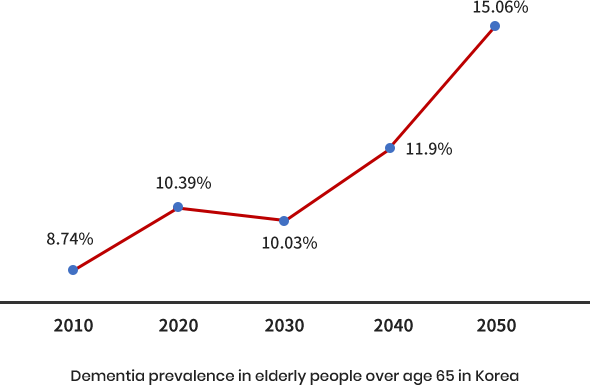
The cost of dementia care has increased by 7.3 times in 2017 from 2007, and the socio-economic burden is expected to further rise in the future.
Treatment of AD is currently limited to acetylcholinesterase inhibitors and N-methyl-D-aspartate (NMDA) receptor antagonists. Acetylcholinesterase inhibitors, like donepezil, rivastigmine, and galantamine are used as treatments for patients with mild to moderate Alzheimer's disease. However, the drugs currently in use are merely symptomatic having little therapeutic effect, and are not applicable for treatment of all AD patients. Thus, fundamental treatments for AD patients are desperately needed.
1. Dementia-related statistics production and management systemization plan. Ministry of Health and Welfare, Korea Institute for Health and Social Affairs
2. Ministry of Health and Welfare, May 2, 2012 Press Release
3. Dementia disease treatment trend analysis. Policy Trend 2018
4. Number of patients with dementia disease by age group and medical expenses 2007-2017. Health Insurance Review and Assessment Service
Parkinson‘s disease (PD)
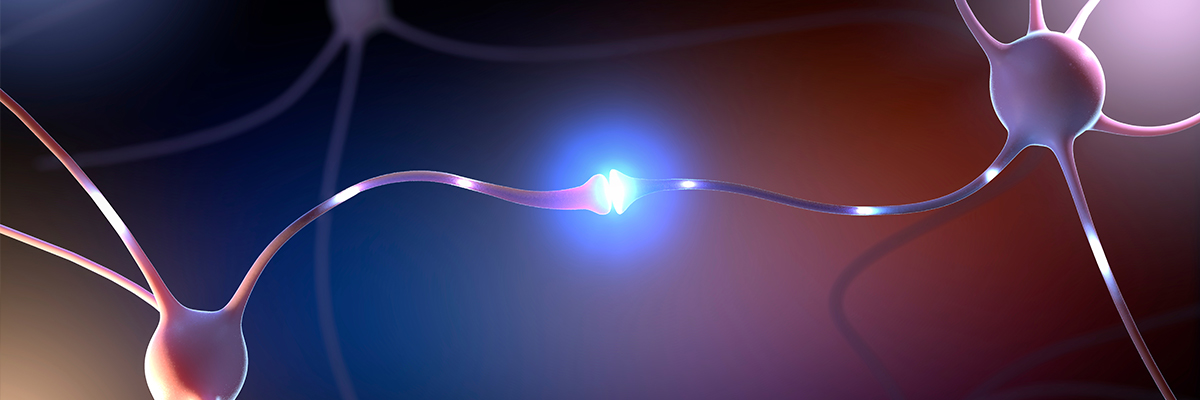
Parkinson's disease (PD) is caused by damage or death of nerve cells, which regulate movement. The three main symptoms of Parkinson's disease are 'bradykinesia' (body movements slow abnormally), 'resting tremor' (hands or feet shake), and 'rigidity', (muscle and joint movements become stiff).
Dopamine is a neurotransmitter that is involved in muscle activity, and adopaminergic loss of more than 60% causes dyskinesia, a symptom of PD. However, the exact cause of damage and death of the nerve cells that control movement has not yet been determined. PD has some genetic etiology, but environmental factors are significant determinants of the disease.
Looking at the distribution of dementia and PD patients in their 40’s and 50’s, patients with PD are about 9 times more prevalent than those with dementia. PD occurs in 1~2 out of 100 people over the age of 65 years.
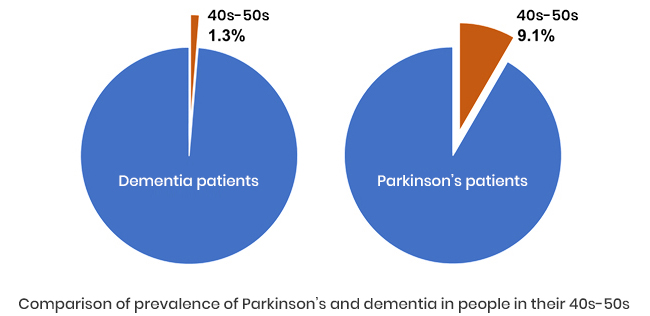
PD’s is accompanied by physical and cognitive impairments, which adds to the economic cost burden. Lack of social and economic support significantly affects the quality of life compared to other degenerative brain diseases.
PD requires medication that takes into account patient's age, condition, and occupation. Drugs currently used for patients with PD are levodopa (a precursor to dopamine) formulation, a dopamine agonist that stimulates the receptor of dopamine, a monoamine oxidase B inhibitor that inhibits dopamine degrading enzymes, and an anticholinergic that helps relieve tremor symptoms including trembling hands and feet. However, these drugs many side effects and can only control the symptoms of PD but cannot cure the disease.
2. Seoul National University Hospital Parkinson’s Center.
http://www.snumdc.org/movement-disorders/parkinson-disease/treatment/Cerebral infarction (CI, stroke)

Cerebral infarction is a neurological symptom that occurs when a blood vessel that supplies blood to a part of the brain is blocked or ruptured, causing damage to the brain. Consequently, there are many different symptoms representatives including paralysis or numbness of the face and one limb, pronunciation disorder, speech disorder, gait disorder, consciousness disorder, and dizziness; in particular, in case of brain hemorrhage, sudden nausea, vomiting, and headache are common. It is necessary to avoid cholesterol-rich food, smoking, and excessive alcohol consumption, carry out regular exercise and undertake regular check-ups for diabetes or heart disease.

Cerebral infarction is a disease in which blood vessels supplying oxygen to the brain become clogged. Few of the several causes including hypertension, diabetes, hyperlipidemia, smoking, excessive alcohol consumption, obesity, and anomalies in blood flow to the brain, can result in brain hemorrhage and cerebral infarction due to lack of adequate blood flow.
Major risk factors of cerebral infarction are aging and increased chronic diseases. According to the acute phase cerebral infarction adequacy evaluation data conducted by the Health Insurance Review and Assessment Service, out of 100 cerebral infarction patients, 76.3% were stroke, 14.5% were intracranial hemorrhage, and 8.9% were subarachnoid hemorrhage. The incidence of cerebral infarction in hypertensive patients is –four to five times higher in the general population and two times higher in diabetic patients. The disease prevalence increased with age, and one in 60 adults is found to suffer from the disease. In addition, according to the analysis of the Korean Stroke Society Epidemiology Research Society, as of 2014, cerebral infarction prevalence was 1.71% in adults over 19 years of age.

Cerebral infarction can cause serious aftereffects or death, and is one of the most socially and economically burdensome diseases in Korea, especially in geriatric population. As of 2015, estimated direct cost of cerebral infarction care was about 1.6840 trillion Won. or 64.3 per 100,000 population, This disease is the second leading cause of death after cancer.
Cerebral infarction, as a single disease in Korea, has the highest mortality rate. The problem is of sequelae (late effects) of cerebral infraction is as serious as patient death. The disease is accompanied by damage in brain cells. The damage can be irreversible even if blood supply is inadequate for only 2-3 minutes, and as a result, many patients experience speech, motor, and cognitive impairments and have difficulties in daily life. For this reason, it is important to take immediate treatment for the disease within the golden time, but only 4 out of 10 patients (40%) visit within 3 hours (the golden time) of the symptom occurrence.

Traumatic Brain Injury

Traumatic brain injury can be defined as brain damage caused by external influences such as traffic accidents, industrial accidents, sports accidents etc. The incidence rate increases as modern society becomes more complex. The most common cause of traumatic brain injury is traffic accidents, which are mostly obstructive and are accompanied by physical or neurological disorders caused by multiple or local injuries. Traumatic brain injury is the leading cause of death and disability worldwide and ,can be fatal especially in children and adolescents.
It is clinically classified into four groups of injury levels: mild, moderate, severe, and vegetative states and the characteristics of each group are as follows.
| States |
|
|---|---|
| Mild (post-concussion syndrome) |
|
| Moderate |
|
| Severe |
|
| Vegetative |
|
Brain injury caused by external impact is mainly caused by coup injury that occurs on the part hitting an object and contrecoup injury that occurs on the other side due to acceleration.

According to the Center for Disease Control (CDC) report in December 2019, the number of traumatic brain injury patients increased by 1.2 fold in 10 years from 983,976 in 2008 to 1,206,345 in 2017. The major areas where damage occurs are the spine (22.1%), traumatic brain injury (14.6%), and knee and lower limbs (11.1%). The proportion of damage inflicted on the nervous system is relatively high; the incidence rate is higher in men (60.5%) than in women (39.5%) and higher in children aged 0-4 years and adults aged 45-54 years.
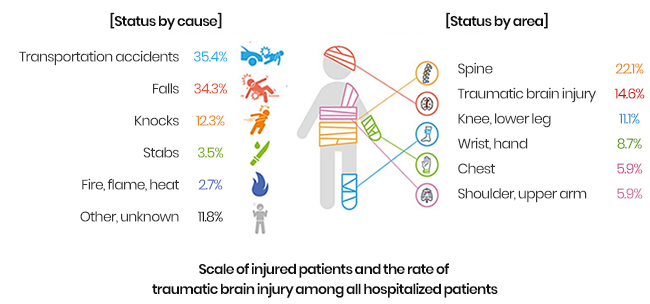
Traumatic brain injury occurs commonly in children or young people with active economic activities. It is not limited to physical pain, but also psychological pain, and physical rehabilitation and various rehabilitation education programs are required. Fortunately, unlike degenerative brain disease, brain's plasticity and resilience is high; therefore, prompt and appropriate first aid immediately after the injury is critical.
1. Severance Rehabilitation Hospital
http://sev.iseverance.com/rehabil/healthinfo/disease_info/dise_sym/ view.asp?con_no=21018&page=2&SearchField=&SearchWord=2. Center for Disease Control: Traumatic brain injury status and prevention strategies
https://is.cdc.go.kr/upload_comm/syview/doc.html?fn=158461875619700.pdf&rs= /upload_comm/docu/0034/3. Medical World News
http://medicalworldnews.co.kr/m/view.php?idx=1510933576Amyotrophic Lateral Sclerosis (ALS)
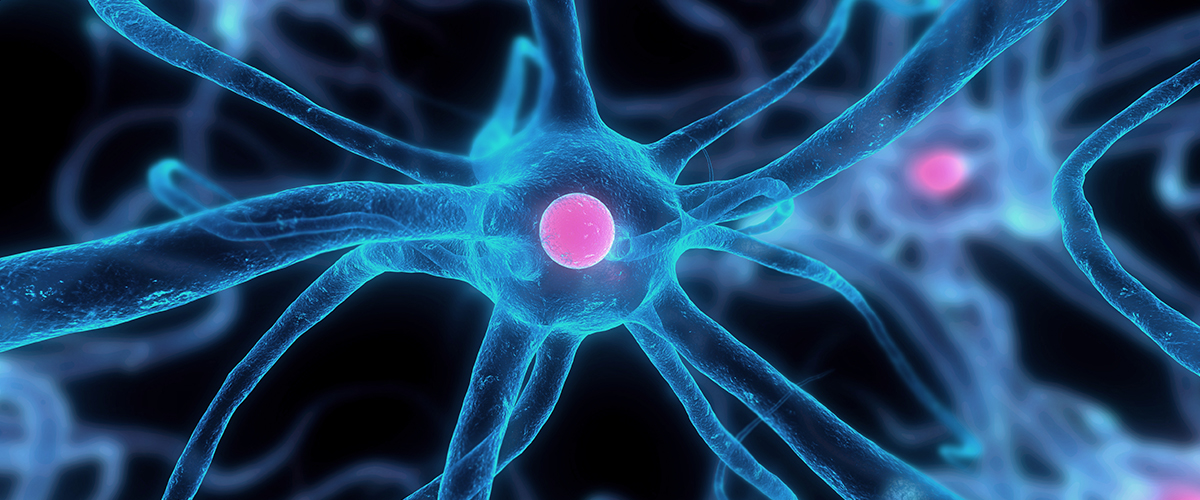
Amyotrophic lateral sclerosis (ALS), also known as Lou Gehrig's disease, is a disease that develops as neuromotor neurons degenerate. The disease manifestations include dysarthria, dysphagia and ultimately dysfunction, such as respiratory failure due to the loss of nerve cells in the brain. Consequently, destruction of the nervous system of the brain stem, spinal cord, and veterinary muscle neurons follow.
It is a neurological disease that begins with mild muscle weakness and progresses to hand movement and micromotor abnormalities, resulting in weakness of the leg muscles, failure of the voice box function, sudden cramps in the muscles, and accelerated muscle reflexes. Depending on the initial symptoms, ALS can be divided into limb and bulbar types.
| Limb type |
|
|---|---|
| Bulbar type |
|
Apart from genetic factors (10%), ALS is known to be associated with damage to motor nerves due to lifestyle and exposure to certain toxic substances, such as group outbreaks caused by specific regional or environmental factors.
The global number of ALS patients per 100,000 populations is 2 to 6, and in the United States, there are approximately 30,000 ALS patients in total and hence, ALS is classified as a rare disease. About 5-10% of the patients belong to the familial ALS due to family history, and the incidence is common in men than in women. The onset of the disease is rare before the age of 40, and most often occurs between 40-70 years.

1. Korea ALS Association (www.kalsa.org)
www.kalsa.org2. . Center for Disease Control, Amyotrophic lateral sclerosis:
http://www.cdc.go.kr/CDC/cms/content/mobile/48/14448_view.html